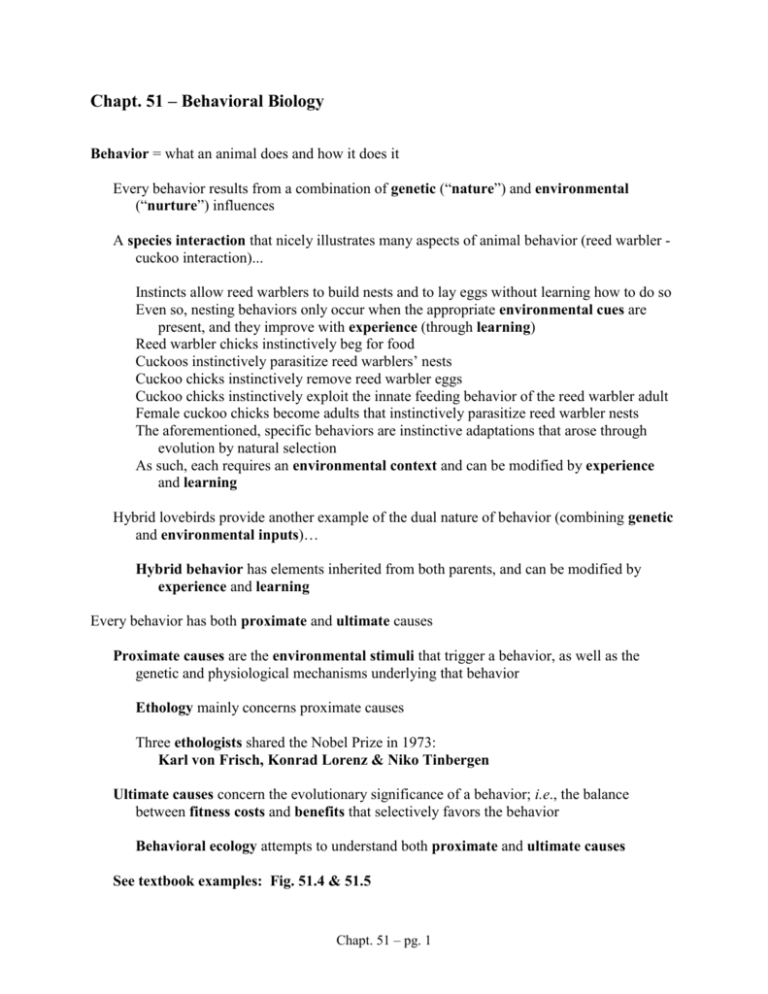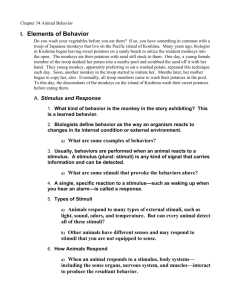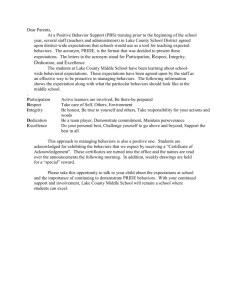doc
advertisement

Chapt. 51 – Behavioral Biology Behavior = what an animal does and how it does it Every behavior results from a combination of genetic (“nature”) and environmental (“nurture”) influences A species interaction that nicely illustrates many aspects of animal behavior (reed warbler cuckoo interaction)... Instincts allow reed warblers to build nests and to lay eggs without learning how to do so Even so, nesting behaviors only occur when the appropriate environmental cues are present, and they improve with experience (through learning) Reed warbler chicks instinctively beg for food Cuckoos instinctively parasitize reed warblers’ nests Cuckoo chicks instinctively remove reed warbler eggs Cuckoo chicks instinctively exploit the innate feeding behavior of the reed warbler adult Female cuckoo chicks become adults that instinctively parasitize reed warbler nests The aforementioned, specific behaviors are instinctive adaptations that arose through evolution by natural selection As such, each requires an environmental context and can be modified by experience and learning Hybrid lovebirds provide another example of the dual nature of behavior (combining genetic and environmental inputs)… Hybrid behavior has elements inherited from both parents, and can be modified by experience and learning Every behavior has both proximate and ultimate causes Proximate causes are the environmental stimuli that trigger a behavior, as well as the genetic and physiological mechanisms underlying that behavior Ethology mainly concerns proximate causes Three ethologists shared the Nobel Prize in 1973: Karl von Frisch, Konrad Lorenz & Niko Tinbergen Ultimate causes concern the evolutionary significance of a behavior; i.e., the balance between fitness costs and benefits that selectively favors the behavior Behavioral ecology attempts to understand both proximate and ultimate causes See textbook examples: Fig. 51.4 & 51.5 Chapt. 51 – pg. 1 For the lovebird example presented in class: Proximate cause: Daylength changes trigger the release of hormones that stimulate a nest-building response Ultimate cause: The fitness benefits have outweighed the costs during the evolution of nest-building behavior Innate behavior Innate (instinctive) behaviors do not have to be learned; the animal performs them correctly with no prior experience A simple kind of innate behavior is a fixed action pattern in response to an external sensory stimulus (a sign stimulus) Human babies have an innate dive reflex Water on the face is the sign stimulus Closing the mouth, holding breath, and kicking constitute the fixed action pattern Male sticklebacks use simple cues to recognize other males [Fig. 51.4] A red “belly” is the sign stimulus An aggressive attack is the fixed action pattern Tinbergen showed that variously shaped models could stimulate the response just as well as real males, supporting the sign-stimulus hypothesis [Fig. 51.3] Tinbergen also showed that gull chicks beg in response to an appropriately colored dot An appropriately colored dot is the sign stimulus Begging is the fixed action pattern Learning can modify innate responses Resembles Goose (when traveling towards the left) -- Chicks ignore Resembles Hawk (when traveling towards the right) -- Chicks crouch in fear With repeated trials, chicks learn that neither shape is dangerous Learned behavior Learned behaviors are those that have been modified by experience Habituation – loss of responsiveness to stimuli that convey little or no information Chapt. 51 – pg. 2 We quickly habituate to “background” noises Habituation prevents an animal from wasting energy on unimportant stimuli Imprinting – learning that is limited to a sensitive period in an animal’s life Lorenz’s classic studies supported his imprinting hypothesis [Fig. 51.5] Adults can also imprint on their offspring, so imprinting is not limited to juvenile stages We humans have a sensitive period for learning language Associative learning – the ability to associate one stimulus with another; includes several forms of conditioning Classical conditioning – learning to associate an arbitrary stimulus with a reward or punishment E.g., Ivan Pavlov’s classic experiments Operant conditioning (a.k.a. trial-and-error learning) – learning to associate one of an animal’s own behaviors with a reward or punishment We quickly learn to associate touching flames with a painful, burning sensation Toads learn to avoid stinging insects through one-trail learning Operant conditioning – the Skinner box Both positive & negative operant conditioning can produce learned behaviors Insight Insight is demonstrated when an animal evaluates a new situation and performs the correct, non-instinctive behavior without prior experience Insight is problem-solving without trail-and-error learning, so it relies on previous experience in contexts other than those that characterize the problem at hand E.g., dog vs. chimp Some adult ravens can figure out how to get meat hanging on a string the first time they are presented with this problem Animal Cognition Cognition, in the narrow sense, is synonymous with consciousness or awareness Cognition, in a broader sense, is the ability of an animal to perceive, store, process, and use information gathered by sensory receptors The extent of non-human cognitive abilities remains a hot, and important, topic of debate Behavior serves many functions… Foraging behavior comprises all of the means by which an animal searches for, recognizes, and manipulates food items Chapt. 51 – pg. 3 There are two main hypotheses for the ultimate reasons for play: 1. The practice hypothesis postulates that play allows animals to perfect behaviors needed later in life 2. The exercise hypothesis postulates that play helps muscular and cardiovascular systems develop properly Movement through space Kinesis – change in activity or turning rate in response to a stimulus [Fig. 51.7] Sowbugs increase rates of travel in dry areas, which helps keep them in moist areas Taxis – oriented movement toward or away from a stimulus [Fig. 51.7] Sowbugs move away from light, which helps keep them in dark places Dispersal (an animal behaviorist’s definition) – one-time movement away from the natal home range [Fig. 51.35] Tinbergen showed that wasps use simple landmark features to find their nests [Fig. 51.14] In this example, female wasps may simply learn to look for a certain pattern of objects A more complicated means of remembering information about locations involves cognitive maps – internal representations of the spatial relationships of objects in an animal’s home range Migration – relatively long-distance periodic movement (e.g., annual) Animals use one, or a combination, of the following to find their way: Piloting – moving from one familiar landmark to the next Orientation – an animal detects compass directions and moves in a straight-line path towards its destination Navigation – an animal uses orientation combined with the ability to determine its present location relative to its target location Social behavior Interactions between or among individual animals of the same species Behavioral ecologists attempt to determine the adaptive significance of social behaviors by elucidating their fitness costs and benefits Mating systems – the costs and benefits of each potential mating system vary from species to species Monogamy Polygamy Polyandry Polygyny ♀+♂ Promiscuity Multiple ♀♀ + Multiple ♂♂ ♀ + Multiple ♂♂ Multiple ♀♀ + ♂ Chapt. 51 – pg. 4 Courtship – behavior patterns that precede copulation (or gamete release in species with external fertilization) As in all behaviors, the balance of benefits and costs determines the direction of natural, or sexual, selection on courtship behaviors One component of the male tungara frogs’ courtship call is especially attractive to females However, that component also attracts frog-eating bats! Courtship often involves rituals – symbolic activities that help individuals assess the health, vigor, or status of other individuals Rituals are also often employed in intrasexual contests for access to mates If neither of two potential combatants “backs down” during a ritual contest, the contest may escalate to a potentially much more costly fight Rituals are important means of defining and re-defining borders of territories (areas within an animal’s home range that it defends against intruders) Many animals live within social groups, and a dominance hierarchy (“pecking order”) defines the dominant vs. subordinate relationships between each pair of individuals Rituals help maintain the status quo dominance hierarchy, and combat is often required for the hierarchy to change Solitary vs. Group living Solitary Some benefits… Decreased intraspecific competition Decreased risk of disease Decreased risk of detection by predators Some costs… Decreased ability to cooperate in finding food Decreased ability to cooperate against predators Decreased likelihood of finding a mate Group living Some benefits… Increased ability to cooperate in finding food Increased ability to cooperate against predators Increased likelihood of finding a mate Some costs… Increased intraspecific competition Increased risk of disease Increased risk of detection by predators Chapt. 51 – pg. 5 Eusociality – a special type of group living in which only one or a few members of the group ever reproduce Non-reproductive members of eusocial societies sacrifice their own individual fitness to increase the fitness of others in the group, i.e., they are altruistic Eusociality challenged the paradigm that selection always favors behaviors that maximize individual fitness W. D. Hamilton first suggested the solution to this apparent problem: inclusive fitness Inclusive fitness – the total effect an individual has promoting the representation of its own genes in future generations, both by producing its own offspring and by providing aid that enables close relatives to produce offspring Hamilton’s Rule Natural selection favors altruism if: rB > C r = relatedness; B = benefits to recipient; C = costs to self Natural selection that favors behaviors that enhance the reproductive success of relatives is called kin selection The coefficient of relatedness (r) in Hamilton’s Rule is the same as the probability that two organisms share a particular gene by direct descent [Fig. 51.34] Female Belding’s ground squirrels give alarm calls that are costly to themselves (exposure to predators), but that confer great benefits to their kin in the colony Communication – an act performed by a sender that serves as a signal and produces a detectable change in the behavior of another individual (the receiver) Communication can be passive E.g., A female mandrill’s colorful buttocks signal that she is fertile Communication can be active E.g. A male lion’s roar can actively signal his presence Communication can be visual E.g. A male Anolis lizard’s dewlap display can signal his quality Communication can be auditory E.g. A vervet monkey’s warning call conveys information about the type of predator Communication can be olfactory/chemical Pheromones are the chemicals that animals use to communicate with one another Communication can be tactile E.g. Grooming and some aspects of courtship behavior are good examples Honeybee communication combines many of these modalities K. von Frisch first described the “waggle dance” of honey bees in the 1940s Honey bees use pheromones, visual, auditory, and tactile signals to communicate information about the location of resources Chapt. 51 – pg. 6





